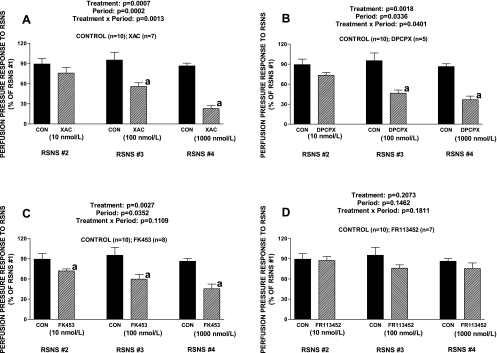Fig. 2.
Bar graphs show effects of increasing concentrations of xanthine amine congener (XAC; A), 1,3-dipropyl-8-cyclopentylxanthine (DPCPX; B), FK453 (C), or FR113452 (D) on perfusion pressure responses to RSNS. The experiment entailed 4 periods of RSNS, and in the XAC, DPCPX, FK453, or FR113452 groups, but not the CON group, XAC, DPCPX, FK453, or FR113452 was added to the perfusate between the first and second periods, second and third periods, and third and fourth periods. The responses to RSNS during the second, third, and fourth periods are expressed as a percentage of the basal response during the first period in the absence of any treatments. Basal perfusion pressures (before treatments) were 58 ± 4, 52 ± 3, 53 ± 1, 55 ± 3, and 55 ± 2 mmHg for the CON group, XAC group, DPCPX group, FK453 group, and FR113452 group, respectively. Basal perfusion pressures were not affected by either XAC, DPCPX, FK453, or FR113452. RSNS responses during the first period (before treatments) were 71 ± 5, 69 ± 16, 101 ± 9, 86 ± 7, and 87 ± 9 mmHg for the CON group, XAC group, DPCPX group, FK453 group, and FR113452 group, respectively. aP < 0.05 compared with CON group in corresponding RSNS period. The P values in the figure are from 2-factor ANOVA. Values represent means ± SE for the indicated number of experiments (n).

